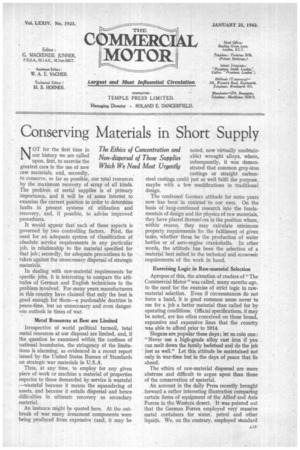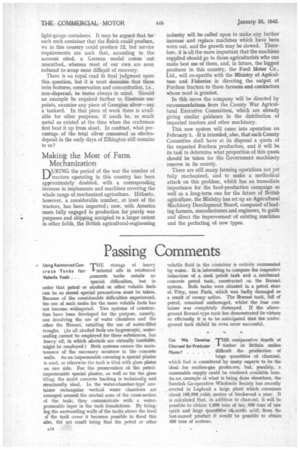Conserving Materials in Short Supply
Page 15

Page 16

If you've noticed an error in this article please click here to report it so we can fix it.
NOT for the first time in our history we are called upon, first, to exercise the greatest care in the use of new raw materials, and, secondly, to conserve, so far as possible, our total resources by the maximum recovery of scrap of all kinds. The problem of metal supplies is of primary importance, and it will be of some interest to examine the current position in order to determine faults in present systems of utilization and recovery, and, if possible, to advise improved procedures.
It would appear that each of these aspects is governed by two controlling factors. First, the need for an adequate system of classification of absolute service requirements in any particular job, in relationship to the material specified for that job ; secondly, for adequate precautions to be taken against the unnecessary dispersal of strategic materials.
In dealing with raw-material requirements for specific jobs, it is interesting to compare the attitudes of German and English technicians to the problem involved. For many years manufacturers in this country have claimed that only the best is good enough for them—a pardonable doctrine in peace-time, but an unnecessary and even dangerous outlook in times of war.
Metal Resources at Best are Limited Irrespective of world political turmoil, total metal resources at our disposal are limited, and, if the question be examined within the confines of national boundaries, the stringency of the limitations is alarming, as evidenced in a recent report issued by the United States Bureau of Standards on strategic war materials in U.S.A.
Thus, at any time, to employ for any given piece of work or machine a material of properties superior to those demanded by service is wasteful —wasteful because it means the squandering of assets, and because it entails dispersal and hence difficulties in ultimate recovery as secondary material.
An instance might be quoted here. At the outbreak of war many armament components were being produced from expensive (and, it may be noted, now virtually unobtainable) wrought alloys, where, subsequently, it was demonstrated that common grey-iron castings or straight carbonsteel castings could just as well fulfil the purpose, maybe with a few modifications in traditional design.
The confessed German attitude for some years now has been in contrast to our own. On the basis of long-continued research into the fundamentals of design and the physics of raw materials, they have placed themsel ves in the position where, within reason, they may calculate minimum property requirements fox the fulfilment of given tasks, whether these be the production of water bottles or of aero-engine crankshafts. In other words, the attitude has been the selection of a material best suited to the technical and economic requirements of the work in hand.
Exercising Logic in Raw-material Selection Apropos of this, the attention of readers of "The Commercial Motor" was called, many months ago, to the need for the exercise of strict logic in rawmaterial selection. Even if circumstances do not force a hand, it is good common sense never to use for a job a better material than called for by operating conditions. Official specifications, it may be noted, are too often conceived on those broad, expansive and expensive lines that the country was able to afford prior to 1914.
Slogans are popular these days ; let us coin one : "Never use a high-grade alloy cast iron if you can melt down the family bedstead and do the job just as well." Let this attitude be maintained not only in war-time but in the days of peace that lie ahead.
The ethics of raw-material dispersal are more abstruse and difficult to argue upon than those of the conservation of material.
An account in the daily Press recently brought forward a rather interesting illustration comparing certain items of equipment of the Allied and Axis Forces in the Western desert. It was pointed out that the German Forces employed very massive metal containers for Water, petrol and other liquids. We, on the contrary, employed standard light-gauge containers. It may be argued that for each such container that the Reich could produce, we in this country could produce 12, but service requirements are such that, according to the account cited, a German model comes out unscathed, whereas most of our own are soon reduced to scrap most difficult of recovery. There is no royal road to final judgment upon this question., but it is most desirable that these twin features, conservation and concentration, i.e., non-dispersal, be borne always in mind. Should an example be required further to illustrate our points, examine any piece of Georgian silver—say a tankard. In that piece of work there is available for other purposes, if needs be, as much metal as existed at the time when the craftsman first beat it up from sheet. In contrast, what percentage of the total silver consumed as electrodeposit in the early days of Elkingtort still remains to us?
Making the Most of Farm Mechanization
DURING the period of the war the number of tractors operating in this country has been approximately doubled, with a corresponding increase in implements and machines covering the whole range of mechanized agriculture. Hitherto, however, a considerable number, at least of the tractors, has been imported ; now, with America more fully engaged in production for purely war • purposes and shipping occupied to a larger extent in other field:s, the British agricultural-engineering industry will be called upon to make any further increase and replace machines which have been worn out, and the growth may be slowed. Therefore, it is all the more important that the machines supplied should go to those agriculturists who can make best use of them, and in future, the biggest producer in this country, the Ford Motor Co., Ltd., will co-operate with the Ministry of Agriculture and Fisheries in directing the output ot FordSon tractors to those farmers. and contractors whose need is greatest.
In this move the company will be directed by recommendations from the County War Agricultural Executive Committees, which are already giving similar guidance in the distribution of imported tractors and other machinery.
This new system will come into operation on February 1. -It is intended, also, that each County Committee shall have at its disposal a quota of the expected Fordson production, and it will be its task to determine what proportion of this quota should be taken for the Government machinery reserve in its county.
There are still many farming operations not yet fully mechanized, and to make a methodical attack on this problem, which has an immediate importance for the food-production campaign as well as a long-term one for the future of British agriculture, the Ministry has set up an Agricultural Machinery Development Board, composed of leading farmers, manufacturers and engineers, to guide and direct the improvement of existing machines and the perfecting of new types.
























































